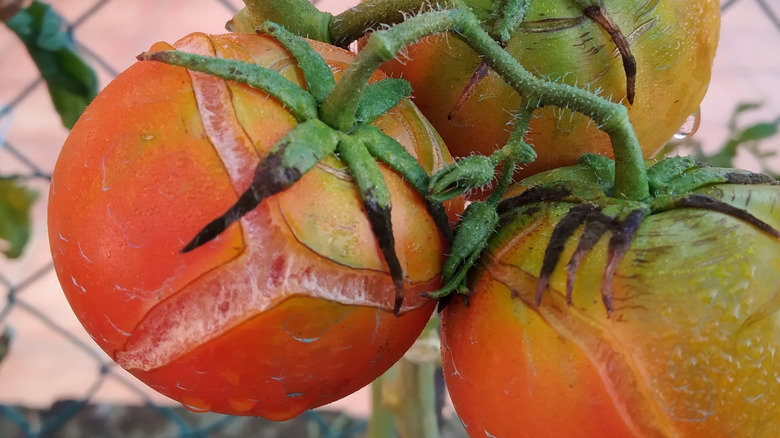The Reason Tomatoes Split When They Ripen
If you pay close attention to the produce grown in your garden or that you peruse at farmers stands or in growers co-op boxes, you have likely seen tomatoes that have split. These fruits almost look like someone has used a paring knife to cut small gashes that have since sealed around the top of the tomato near where the stem once was. That odd appearance in the tomatoes actually comes from an irregular growing cycle, according to Allrecipes.
In order for tomatoes to have a perfect exterior without splits, tomatoes must be grown in an environment that gets just enough water regularly and without any change. When tomatoes get too much water, be it overwatering or a heavy storm, it causes the interior part of the ripened fruit to grow faster than the skin. This can also happen when conditions simply change too quickly, such as dry weather after a rainy season.
Why you should eat most of them anyway
While split tomatoes might not look as perfectly clean and cosmetically beautiful, that does not mean they are not worth eating. According to Forbes, the beauty standards inflicted on produce in grocery stores account for nearly half of all food waste. And that's exactly why many socially- and environmentally-conscious people actively seek out "imperfect" or "ugly" produce. And split tomatoes certainly fall into this category.
Though split tomatoes are not perfect on the outside, they can still taste just as juicy and delicious as any other tomato. This being said, Gardener's Path does offer a word of caution against very large splits found in homegrown tomatoes, as this could signal an exposure to bacteria. The site advises cutting away the splits, if small enough; and if too big, to consider adding the ruptured tomato to the compost pile.
According to Allrecipes, this phenomenon can affect not only ripe tomatoes but green tomatoes, too. So, if you are growing your own fresh fruit in a home garden or buying it elsewhere, keep in mind that the slightly odd-looking green and red tomatoes should both be perfectly fine to use in salads and sandwiches and for cooked recipes like omelets and sauces.

